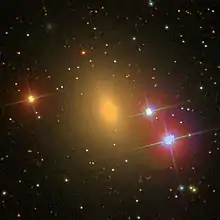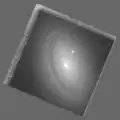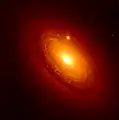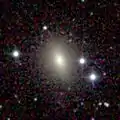NGC 1161
NGC 1161 is a lenticular galaxy approximately 90 million light-years away from Earth in the constellation of Perseus.[3] It was discovered, along with NGC 1160, by English astronomer William Herschel on October 7, 1784.[4]
| NGC 1161 | |
|---|---|
 NGC 1161 (SDSS) | |
| Observation data (J2000.0 epoch) | |
| Constellation | Perseus |
| Right ascension | 03h 01m 14.10s [1] |
| Declination | +44° 53′ 50.00″ [1] |
| Redshift | 0.006518 [1] |
| Helio radial velocity | 1954 ± 23 km/s [1] |
| Distance | 90 Mly |
| Apparent magnitude (V) | 11.10 [2] |
| Apparent magnitude (B) | 12.10 [2] |
| Characteristics | |
| Type | S0 [1] |
| Apparent size (V) | 2.8 x 2.0 [1] |
| Other designations | |
| PGC 11404, MCG +07-07-015, UGC 2474 | |
NGC 1161 is classified as a Type 1.9 Seyfert galaxy.[5] It forms a visual pair with the galaxy NGC 1160. Both galaxies are located between the Local and Perseus superclusters in the Perseus Cloud close to the centre of the Local Void.[6]
Image gallery
 NGC 1161 (NASA/ESA HST)
NGC 1161 (NASA/ESA HST) NGC 1161 (NASA/ESA HST)
NGC 1161 (NASA/ESA HST) NGC 1161 by 2MASS
NGC 1161 by 2MASS
References
- "NASA/IPAC Extragalactic Database". ned.ipac.caltech.edu. Retrieved March 3, 2019.
- "Revised NGC Data for NGC 1161". spider.seds.org. Retrieved March 3, 2019.
- "NGC 1161". Retrieved March 3, 2019.
- "Data for NGC 1161". www.astronomy-mall.com. Retrieved March 3, 2019.
- Filho, Mercedes E.; Barthel, Peter D.; Ho, Luis C. (2006). "A Radio Census of Nuclear Activity in Nearby Galaxies". Astronomy & Astrophysics. 451 (1): 12. arXiv:astro-ph/0601080. doi:10.1051/0004-6361:20054510.
- Gregory, Stephen A.; Thompson, Laird A.; Tifft, William G. (1981). "The Perseus Superclaster". The Astrophysical Journal. 243: 416. doi:10.1086/158608.
External links
| Wikimedia Commons has media related to NGC 1161. |
- NGC 1161 on WikiSky: DSS2, SDSS, GALEX, IRAS, Hydrogen α, X-Ray, Astrophoto, Sky Map, Articles and images
- SEDS
This article is issued from Wikipedia. The text is licensed under Creative Commons - Attribution - Sharealike. Additional terms may apply for the media files.
